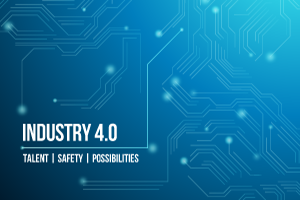Our Latest News

INDUSTRY 4.0 – TALENT, SAFETY AND POSSIBILITIES
This is the 4th Industrial Revolution. After the steam revolution – which led men to stop using animals to produce force -, after the electricity and mass production revolution – which meant an increase in well-being and comfort – and the revolution of microprocessors and computing – which brought a new leap to efficiency and productivity – we are now living the Internet of Things (IoT) and Artificial Intelligence Revolution.
Understood as a technological mosaic, Industry 4.0 is composed of industries that rely heavily on information technology and the traditional industries that able to adapt to it. Agriculture, transportation and others have adapted and adopted new processes, policies, techniques and practices, proving that the traditional industrial sectors are as capable of technological modernization as the advanced ones.
In fact, the core strategy of the Industry 4.0 is innovation through the so-called “smart systems”. In it, products, logistics systems and networks are based on the integration through the Internet of Things. Ultimately, this new era is expected to lead to a growing integration of data across the product and asset lifecycle to improve planning, development, and a more flexible response to the Market’s needs.
With the changing industry paradigm, companies are faced with challenges that have impacts at different levels of the organization. In this article, we propose a reflection centered on Talent, Safety and the potential of IoT.
Talent and digitization: changes in the workforce
In an era governed by digitization, talent raises two main questions. First, it is estimated that the increasing use of technology will add value – the workforce will be more mobile and overcoming location constraints will possibly help individuals to work smarter. Another aspect refers to the workers’ expectations. Collaboration, on-demand access to information and changing work environments have fostered a change in expectations about their functions. In addition, with the integration of Information Technologies, these are often faced with new requirements in terms of planning, execution and guarantee of new systems. Not forgetting the millenials, they are not only more available to use new technologies, but also more demanding in terms of usage of these means for the execution of their daily work tasks. Having tools and technologies that increase efficiency and productivity are motivating factors for the generation that is now emerging in the labor market.
Although the number of workers with training to work Big Data unstructured data and tools is gradually increasing, it is still short when it comes to the estimated future demand. In response to this challenge, collaboration with other institutions, companies, universities and institutes enables companies to be able to develop streams of talented workers, attracted by the potential of new advanced digital production technologies.
Security: the challenges of data privacy
Industry 4.0 also addresses issues related to the threats and vulnerability of data access. When it comes to their systems, companies face new protection needs, being aware of new risks and resilient to limit damage and restore operations.
The Internet of Things requires the development and adequacy of existing security measures – companies focus on tasks such as assessing, maintaining and revoking trust between different devices, seeking to control access, secure routing of information and detection of Intruders, among other aspects.
As companies and industries adapt to the new reality of the Industry 4.0, daily improvements in digital security bring a natural response to recent events. Placing safety first and evaluating, preparing and implementing the necessary safety volume, at the right access points, to obtain functional integrity of all systems and ensure the safety of the collected and processed data are aspects that dictate, already today, the success and failure of companies.
The rapid expansion of the Internet of Things possibilities
Rapid developments in technology are expanding production possibilities. The development of advanced technologies such as robotics, artificial intelligence, sensors, augmented reality and other cognitive technologies is vital to increasing global industrial competitiveness. But which are CEOs’ priorities?
2016’s Global Manufacturing Competitive Index report, developed by Deloitte and the US Competitiveness Council, explains that predictive analytics, smart connected products and advanced materials are the three most promising aspects cited by US CEOs. Already in China, CEOs are giving priority to predictive analytics and the development of smart factories, seeking to create a competitive advantage through high-performance computing. At the European level, smart factories, smart, connectable and digital design, simulation and integration are the top priorities.
In addition, at a global level, companies are looking for growth opportunities in the services provided to their clients. After-sales service through connected devices that monitor the equipments’ performance and that, through analysis, enales to predict potential failures and perform repairs and maintenance, are two examples of the Internet of Things potential.
Digitization opens up great possibilities. In a time when the limits on the technological evolution are not yet defined, to be globally competitive companies need to think strategically about how they can meet the challenges and manage the opportunities. Its success will be dictated by the ability to evolve and reinvent themselves, following the technological innovations’ evolution and taking advantage of them.



